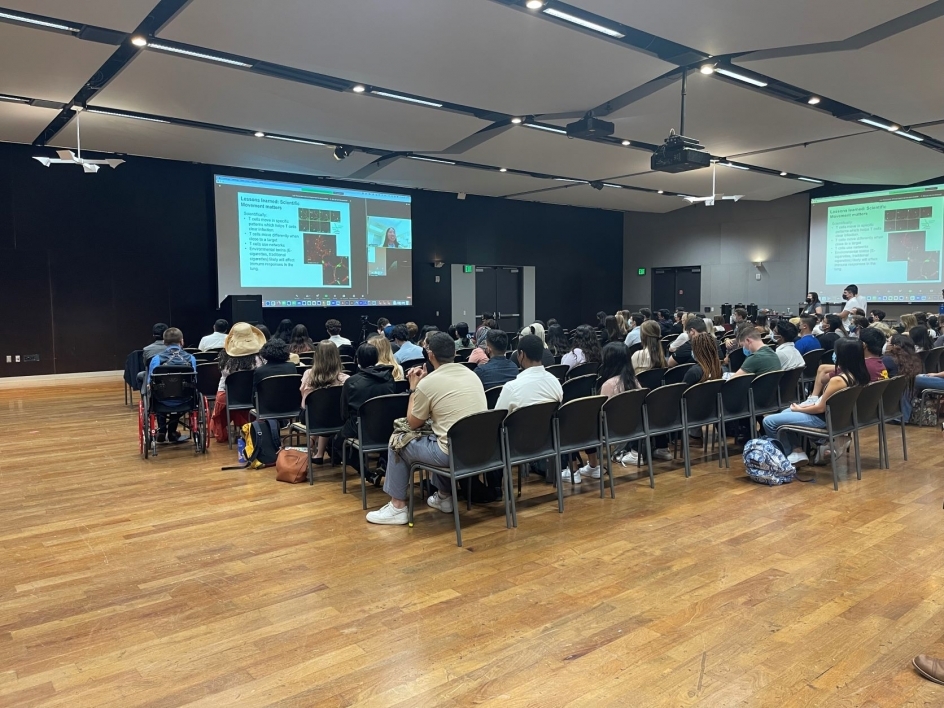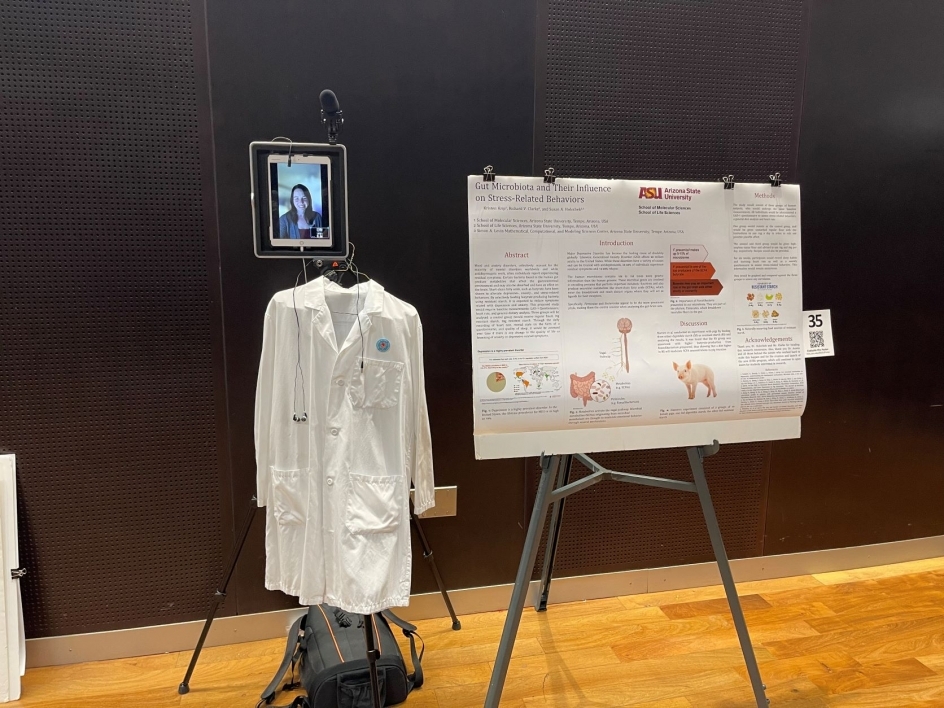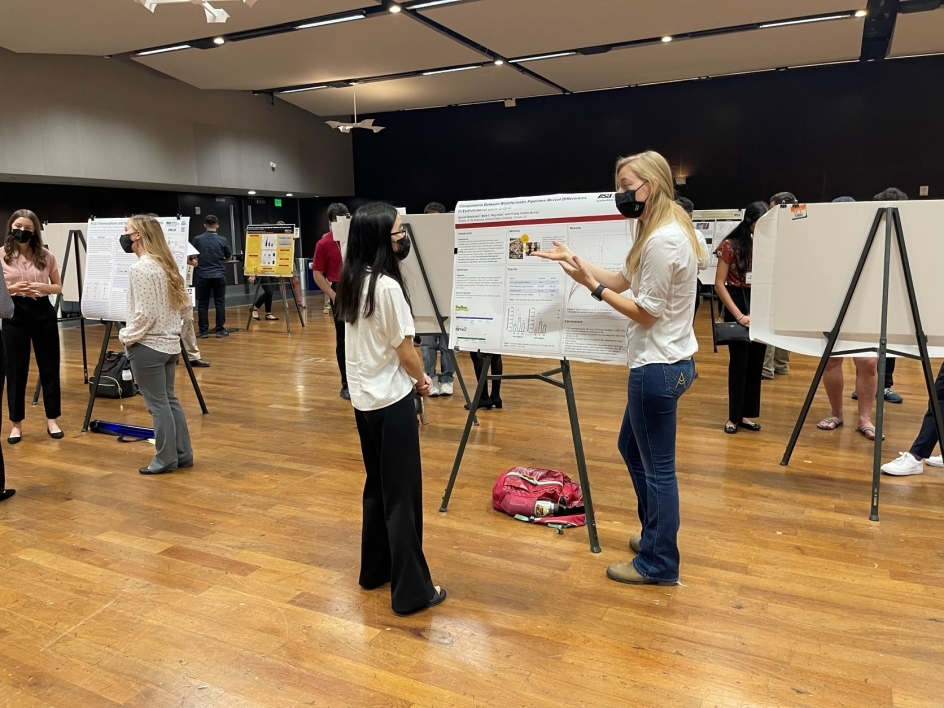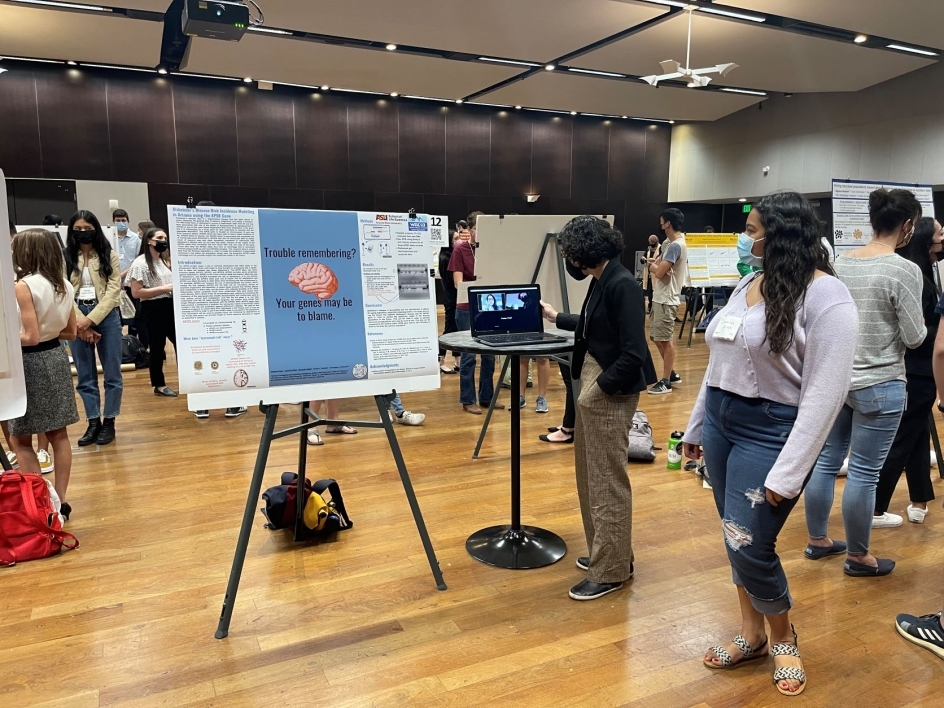Bridging the gap between online and on campus
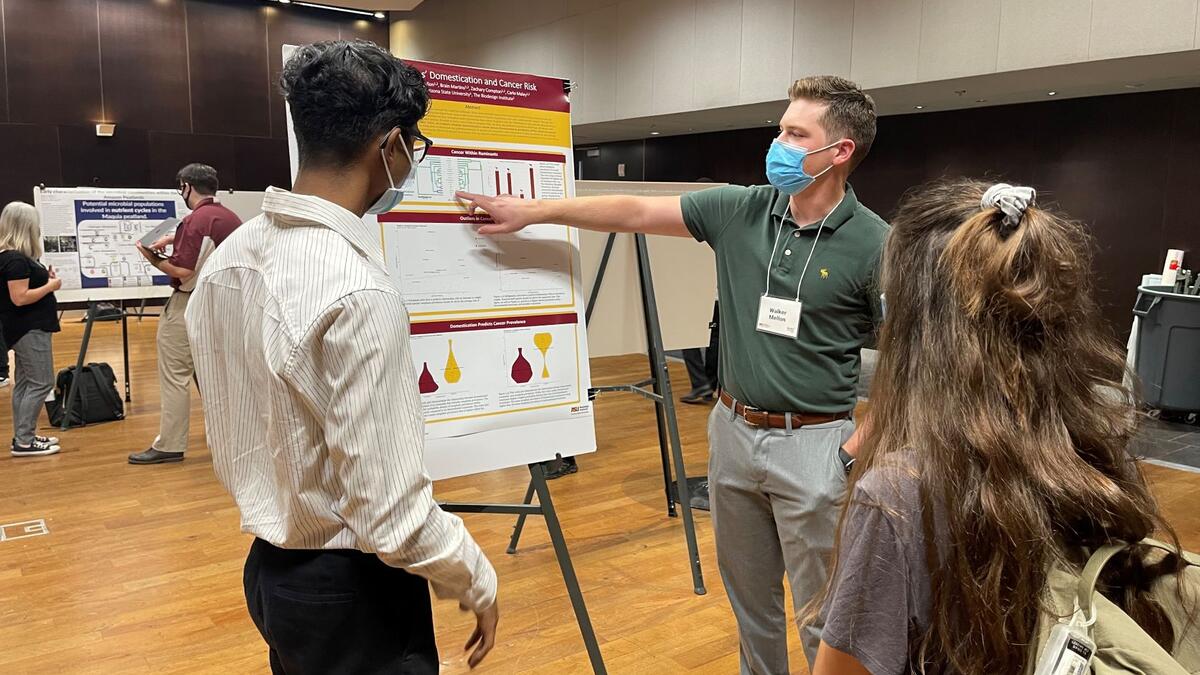
The BioSci Southwest Symposium was hosted by the School of Life Sciences, a joint effort between its Graduate Programs and Undergraduate Research Program. The event included more than 40 poster presentations and 11 lightning talks by students to display their research conducted in ASU labs.
Karen Amos waited excitedly next to her research poster during this year's School of Life Sciences’ BioSci Southwest Symposium. In the Memorial Union on Arizona State University's Tempe campus, guests gathered around her poster about embryonic stem cells and listened to her explain her project, asking questions about her findings and research techniques.
But Amos wasn’t on campus — she was in Tennessee.
For the first time, the regional symposium was held as a hybrid event, utilizing innovative techniques to open the doors to both on-campus and online participants.
“There’s a lot of really good science ideas that are stuck behind a computer screen,” said Amos, who is a senior studying biochemistry through ASU Online.
“I’ve never had this type of opportunity before. We now have the opportunity for face-to-face research, which has been unheard of to online students.”
The COVID-19 pandemic continues to produce rapid accelerations in technology, and disciplines across ASU have been swift to adapt these tools to better serve the educational needs of students. The fusion of traditional, in-person event formatting with innovative virtual platforms has allowed online students to participate in an interactive research conference, an opportunity they have never had before.
A new way to gather
On Oct. 29, the annual BioSci Southwest Symposium was held in the Arizona Ballroom of the Memorial Union on the Tempe campus. The event included more than 40 poster presentations and 11 lightning talks by students to display their research conducted in ASU labs.
The symposium is hosted by the School of Life Sciences, a joint effort between its Graduate Programs and Undergraduate Research Program. The event gives students the opportunity to display their work in the community and practice their presenting skills to a broader audience.
Paula Baker, School of Life Sciences senior program coordinator, organized the symposium and ensured the event ran smoothly and efficiently.
“Many of our online students are nontraditional in the sense that they might have families, full-time jobs, etc. Hybrid events allow them to connect in ‘real time’ while decreasing barriers to attendance,” Baker said.
Student researchers who were unable to attend in person sent their poster ahead of time to be printed and put on display in the ballroom. Next to their poster was a laptop, or tripod with a tablet computer, and a microphone. Guests walking through the presentations could plug their headphones into the device and engage in a live conversation with the online presenter.
The symposium also gave students the space to network with other researchers and ASU faculty members.
The event included a lecture by keynote speaker Judy L. Cannon, a researcher and associate professor from the University of New Mexico Health Sciences Center. Cannon studies immune responses, and she discussed the movement of immune cells and how it helps clear infections like the flu and COVID-19. She also shared her career path and offered advice for students who want to pursue a career in scientific research.
Following Cannon’s remarks, each student, or team of students, presented their poster, summarizing the research they conducted. Guests walked around the ballroom, observing various fields of research.
The symposium included one hour of “lightning talks” that were given between poster presentations. Eleven presenters gave five-minute slideshow presentations of their research in front of all the in-person and virtual attendees.
To allow greater access to each project, the poster presentations were divided into two sessions. Presenters each prepared both a virtual and physical poster. During the first session, half the groups presented in the ballroom, while half presented virtually through a platform called GatherTown.
GatherTown is a website for interactive virtual spaces. Individuals who attended the symposium virtually were able to log in to GatherTown and hear students present their research. By using the arrow keys on a keyboard, attendees could move an avatar across the screen to walk around a virtual, 2D symposium. As their avatar passed tables with the presenter’s name on them, the presenter was notified and their Zoom video feed automatically opened to begin presenting to the attendee.
Building bridges
The hybrid format of the symposium set a new precedent for ASU events.
Undergraduate research experiences and the opportunity to present to a crowd are invaluable for students pursuing graduate programs and careers in STEM, and the lack of an in-person lab component had many wondering whether fully online STEM degree programs were even possible.
In early days, online students fulfilled lab requirements at local partnering community colleges wherever possible and were left to their own devices to supplement their online coursework with professional development opportunities.
Merging virtual technology like Zoom and GatherTown with in-person events is a pivotal step in bridging the gap between online and immersion degree programs.
While the pandemic has had drastic effects on communities worldwide, the virtual solutions developed by the university are proving to be a silver lining. The COVID-19 pandemic accelerated ASU’s production of innovative technologies and out-of-the-box methods of learning.
“This event was a way of taking advantage of the technology that COVID-19 brought into our lives,” Baker said. “COVID-19 pushed us to use technology in an innovative and creative way that we never would have thought about before.”
Over 200 people participated in the symposium between in-person and virtual attendance. With the hybrid format being a huge success, the School of Life Sciences intends on structuring other events in a similar way. The Spring 2022 Undergraduate Research Symposium will follow the same structure with both in-person presenters and online presentations via Zoom and GatherTown.
“We are very proud with how far we have progressed with the BioSci Southwest Symposium since its inception three years ago,” said Shelley Haydel, School of Life Science associate director of undergraduate programs. “I am remarkably proud to be the founding organizer for the event, and to see and experience its growth and expansion throughout the past three years and through the COVID-19 pandemic.”
ASU is committed to finding new and innovative ways to make education more inclusive for all students, with more than 120 STEM degree programs currently available through ASU Online.
The School of Life Sciences serves as an important catalyst in this mission, piloting multiple programs to design and implement virtual solutions for student success. One example of these is the Online Undergraduate Research Scholars (OURS) Program, which launched this fall in The College of Liberal Arts and Sciences' natural sciences division.
In addition to research events such as the BioSci Southwest and Spring Undergraduate Research Symposiums, the school is implementing multiple targeted initiatives to increase hands-on research opportunities for undergraduate ASU Online students. Interested students are encouraged to talk to their professors to learn more about new positions and programs available.
The program for the BioSci Southwest Symposium, which includes abstracts for the research presentations, can be found here.
More Science and technology

Breakthrough copper alloy achieves unprecedented high-temperature performance
A team of researchers from Arizona State University, the U.S. Army Research Laboratory, Lehigh University and Louisiana State…

4 ASU researchers named senior members of the National Academy of Inventors
The National Academy of Inventors recently named four Arizona State University researchers as senior members to the prestigious…

Transforming Arizona’s highways for a smoother drive
Imagine you’re driving down a smooth stretch of road. Your tires have firm traction. There are no potholes you need to swerve to…


